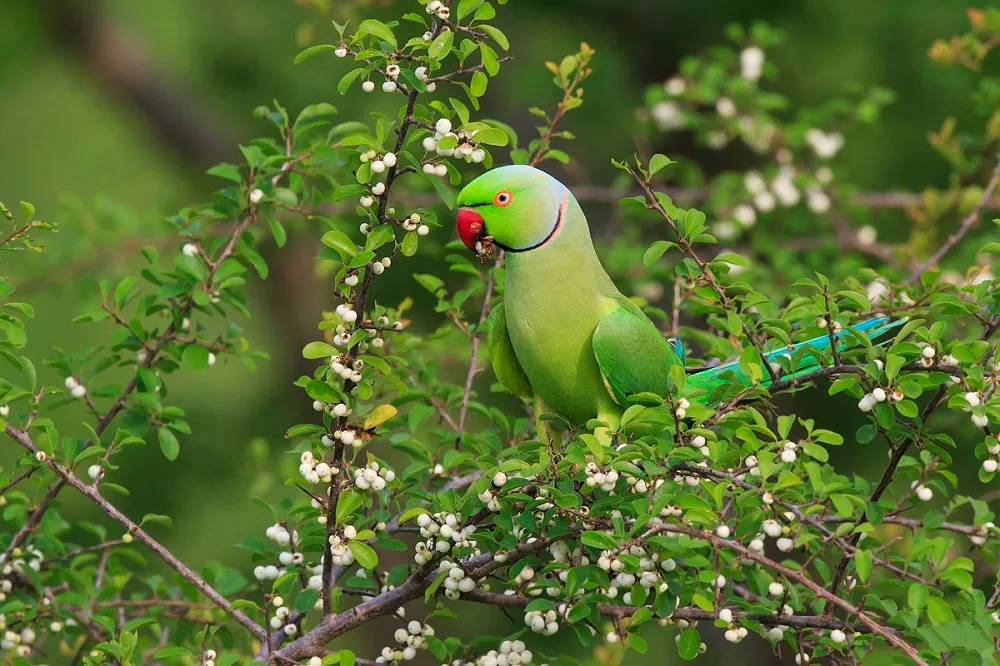The Ringneck Parrot, scientifically known as Psittacula krameri, is a captivating and popular species of parrot that has captured the hearts of bird enthusiasts worldwide. Also commonly referred to as the Indian Ringneck Parrot or Rose-ringed Parakeet, these colorful and intelligent birds boast a distinctive appearance and an array of charming behaviors. This article aims to provide a comprehensive overview of the Ringneck Parrot, highlighting its physical characteristics, natural habitat, behavioral traits, and popularity as a pet.
Characteristics of the Ringneck Parrot:
The Ringneck parrot is renowned for its striking appearance. It boasts a slender body, measuring approximately 16 inches in length, with a long, elegant tail. Its most distinguishing feature is the colorful ring that encircles its neck, which varies in color depending on the subspecies. The male Ringneck parrot typically displays a vibrant green plumage, while the female exhibits a more subdued hue. Additionally, these parrots possess a hookedak, ideal for cracking open nuts and seeds, their primary dietary staples.
Natural Habitat and Distribution:
Ringneck parrots are native to various regions across Africa and Asia. They inhabit diverse habitats, including woodlands, forests, savannas, and even urban areas. In the wild, they can found in countries such India, Sri Lanka, Pakistan, and parts of sub-Saharan Africa. However, due to their popularity as pets, Ringneck parrots have been introduced to numerous other countries, leading to established populations in regions like Europe, North America, and Australia.
Behavior and Social Structure:
Ringneck parrots are highly social creatures that form strong bonds within their flock. They are known for their playful and curious nature, often engaging in acrobatic displays and vocalizations to communicate with one another. These parrots are intelligent and have the ability to mimic human speech, making them popular pets. In the wild, they exhibit complex social hierarchies and communicate through a range of vocalizations, including squawks, whistles, and chirps.
Reproduction and Life Cycle:
The breeding season for Ringneck parrots typically occurs during the spring and summer months. Males engage in elaborate courtship displays to attract females, showcasing their vibrant plumage and engaging in aerial acrobatics. Once a pair has formed, they construct nests in tree cavities or crevices, where the female lays a clutch of 2-4 eggs. Both parents take turns incubating the eggs and caring for the hatchlings. The chicks fledge after approximately 7-9 weeks and become independent within a few months.
Conservation Status and Threats:
While the Ringneck parrot is not currently classified as endangered, certain subspecies face threats due to habitat loss, illegal trapping for the pet trade, and competition with invasive species. Conservation efforts are crucial to ensure the long-term survival of these magnificent birds. Initiatives such as habitat preservation, captive breeding programs, and public awareness campaigns play a vital role in protecting the Ringneck parrot and its natural habitat.
The Ringneck Parrot as a Pet:
Due to their striking appearance and ability to mimic human speech, Ringneck parrots have become popular pets worldwide. However, potential owners must aware of the responsibilities that come with keeping these intelligent birds. Ringneck parrots require a spacious cage, mental stimulation, a balanced diet, and regular social interaction to thrive in captivity. It is essential to provide them with enriching environment that mimics their natural habitat to ensure their physical and psychological well-being.
10 Interesting Facts About Ringneck Parrots
Here are some interesting facts about Ringneck parrots:
1. Native Habitat: Ringneck parrots are native to parts of Africa and Asia, including India and Sri Lanka. They have also been introduced to various other regions around the world.
2. Colorful Plumage: Adult male Ringneck parrots have a vibrant green plum with a distinctive black ring around their necks, hence the name “Ringneck.” Females have a similar appearance but lack the black ring.
3. Long Lifespan: With proper care and nutrition, Ringneck parrots can live for 25 to 30 years or even longer in captivity. This makes them long-term companions for bird enthusiasts.
4. Talking Ability: Ringneck parrots are highly intelligent and have the ability to mimic human speech. They can learn a wide range of words and phrases and may even develop the ability to hold simple conversations with their owners.
5. Playful and Active: These parrots are known for their playful and active nature. They enjoy climbing, swinging, and exploring their surroundings. Providing them with toys and regular out-cage time is essential for their mental and physical well-being.
6. Social Birds: Ringneck parrots are social creatures and thrive on interaction with their human companions. They require regular socialization and mental stimulation to prevent boredom and behavioral issues.
7. Nesting Habits: In the wild, Ringneck parrots nest in tree hollows. They are cavity nesters and use their beaks to excavate nesting sites. In captivity, they can be provided with nest boxes to simulate this natural behavior.
8. Varied Diet: Ringneck parrots have an omnivorous diet that includes seeds, fruits, vegetables, nuts, and occasionally insects.’s important to provide them with a balanced diet to ensure their nutritional needs are met.
9. Mating Behavior: During the breeding season, male Ringneck parrots display courtship behavior by bobbing their heads, fluffing their feathers, and making soft cooing sounds. They may also offer food to the female as part of their courtship ritual.
10. Popularity as Pets: Ringneck parrots are popular pets due their striking appearance and ability to mimic speech. However, they require dedicated care, socialization, and mental stimulation to thrive in captivity.
Conclusion:
In conclusion, the Ringneck parrot a captivating avian species renowned for its vibrant plumage, distinctive ring around its neck, and remarkable intelligence. Its natural habitat, behavior, and conservation efforts are all crucial aspects to consider when appreciating these magnificent birds. Whether observed in the wild or kept as pets, the Ringneck parrot continues to captivate bird enthusiasts worldwide with its beauty, intelligence, and unique characteristics. understanding and protecting this species, we can contribute to the preservation of avian biodiversity and ensure a future where these remarkable birds continue to grace our skies.


 Facebook
Facebook  Instagram
Instagram  Youtube
Youtube 